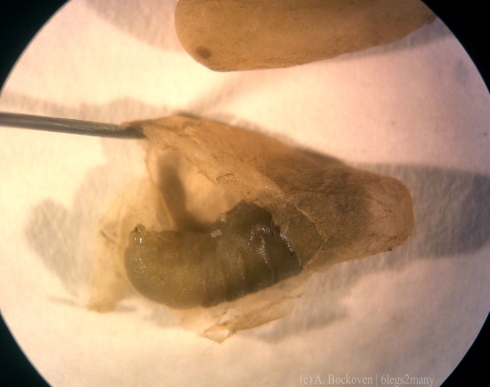Ants, like butterflies, are holometabolous and go through complete metamorphosis with an egg, a larva (~caterpillar), a pupa (~chrysalis/cocoon), and adult ant (~butterfly). In ants, the larvae resemble small white grubs and cannot move by themselves–they are fed and tended by the worker ants.
The larvae are covered in fine hairs which help them stick together in clumps, making it easier for adult workers to move and tend them. In fire ants, these hairs also help with rafting behavior, because they can trap a layer of oxygen around the larvae, helping them breathe and making them extra buoyant. Rafting fire ant colonies use their babies as tiny floatation devices. Please take a moment to consider the wonder of nature.
As they grow, the larvae molt several times, and each growth stage is referred to as an instar. The larvae pictured above are extremely tiny because they are first instar larvae, having only recently hatched.
When the larvae are old enough they prepare to metamorphose into adults. Some ants, like these carpenter ants, spin themselves into cocoons to pupate, while others, like fire ants, leave their pupae exposed. Above, you can see an opened cocoon that contains a larvae that has not yet molted into its pupal form.
Additional fun fact: ant larvae have a closed digestive tract (I assume to prevent them from making a mess all over the colony. It’s like the ant equivalent of diapers.). They poop for the first time when they molt into pupae. Best line from a paper ever: “…the larva defecates for the first time…. Workers help out.” (Taber, 2000). This is also the least appealing job description.
While the job of the larva is eating and growing, the job of the pupa is developing–reorganizing its system into an adult ant. Ant pupa look basically like unmoving, pale adult ants, darkening up right before their final molt to adulthood. The newly molted ants are still fairly pale and soft-bodied. They are referred to as “callows.” Their exoskeleton darkens as it hardens, until they are prepared to go about the daily business of an adult worker ant.
PS: Here is a cool video of a queen ant helping a pupa shed its old larval skin.






Alison,
I don’t “do” ants, although I’ve probably read all of E. O. Wilson’s books, and he’s quite a hero to me. While filling out my last BioQuip order, I decided to order an aspirator (which Dr. Wilson calls a “pooter”). When it came it, I was sitting out on the porch, enjoying a refreshing adult beverage when I noticed what I’m PRETTY sure were big carpenter ants, so I whipped out the pooter. Thought I’d POISONED myself. Those ants sure give off a BIG stink, which I inhaled and soon found myself choking on. I’ll probably stick with my odonates and beetles.
Hahaha, oh no. Yes, that definitely sounds like carpenter ants. Like other formicines, they spray formic acid when disturbed. And you definitely notice it when you try aspirating them. Or when someone else does and has to cough. We call it aspirator lung. Luckily I hardly ever have to work with carpenters. Camponotus and Formica are the only ants I’ve aspirated that spray like that. The vast majority of ants in my area (including any ants that sting and plenty that don’t) are no problem.
I’m in the Missouri Ozarks. I just sent pictures of all the ants I captured that day to James Trager, who seems to be our “Missouri Ant Guy”, hoping for some ID. My taxonomy skills are only surpassed by my crappy photography skills, though. One of the interesting ones was about the size of the Camponotus, but was reddish in color. There were also a couple of very tiny (about 2mm) guys, one almost the color of a golden raisin, and the others rather dark. The only fieldguide I have is Fisher/Cover’s “Ant of North America: A Guide to the Genera”, but I’m not very proficient with it.